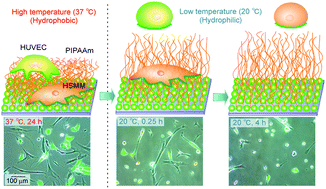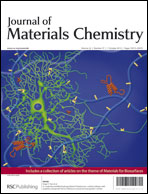Poly(N-isopropylacrylamide) (PIPAAm) brush grafted glass surfaces with various brush lengths were prepared as cell separating intelligent interfaces through a surface-initiated atom transfer radical polymerization (ATRP) with a CuCl–Me6TREN catalytic system and α-chloro-p-xylene as a free initiator in 2-propanol at 25 °C for 16 h. Characterization of the prepared surface was performed by X-ray photoelectron spectroscopy (XPS), attenuated total reflection Fourier transform infrared (ATR/FT-IR) spectroscopy, and gel permeation chromatography (GPC) measurement of PIPAAm in ATRP reaction solution for estimating the brush length. Phase transition behavior of PIPAAm in four cell culture media was also investigated by measuring the temperature-dependent turbidities. Prepared PIPAAm brush surfaces as cell separating intelligent interfaces were characterized by observing the adhesion and detachment behavior of four types of human cells: human umbilical vein endothelial cells (HUVECs), normal human dermal fibroblasts (NHDFs), human aortic smooth muscle cells (SMCs), and human skeletal muscle myoblast cells (HSMMs). The PIPAAm brush surface with a moderate brush length exhibited a proper cell adhesion and detachment behavior, while short-brush-surfaces scarcely detached cells and long-brush-surfaces scarcely adhered cells. The PIPAAm brush with a moderate brush length exhibited different cell detachment rates among individual cell types. Utilizing the different cell detachment properties, a mixture of green fluorescent protein (GFP) expressing HUVEC (GFP-HUVEC) and HSMM was separated. After being allowed to adhere on the surfaces at 37 °C for 24 h, the adhered cells on the surfaces were incubated at 20 °C. In the initial period of incubation at 20 °C, the GFP-HUVEC was released from the surface due to its prompt detachment property, and, in the subsequent period of incubation, HSMMs gradually detached themselves from the surface. These results indicated that a precisely designed PIPAAm brush functioned as an intelligent cell separating interface by utilizing the intrinsic cell detachment properties of individual cells.

You have access to this article
 Please wait while we load your content...
Something went wrong. Try again?
Please wait while we load your content...
Something went wrong. Try again?


 Please wait while we load your content...
Please wait while we load your content...